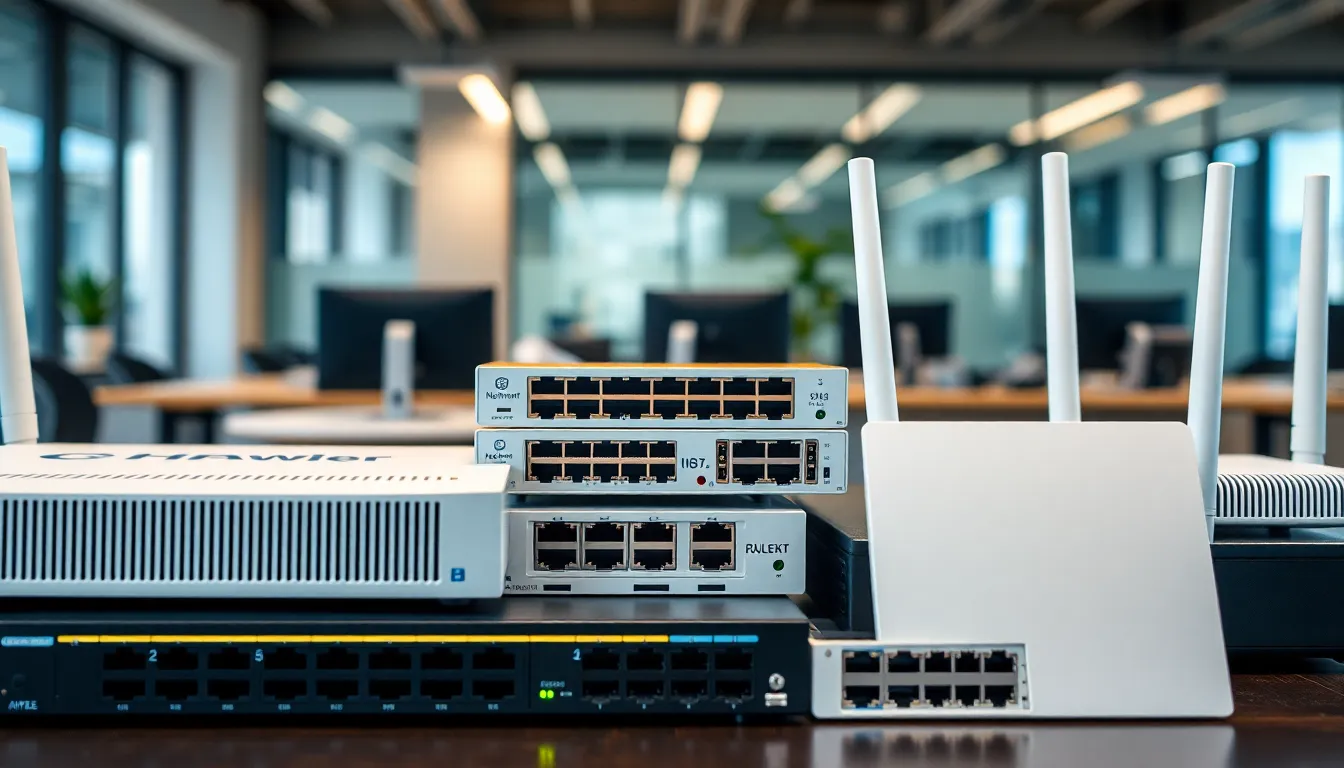In today’s digital landscape, network hardware plays a crucial role in connecting devices and enabling seamless communication. From routers to switches, these components form the backbone of any network, ensuring data flows efficiently and securely. As businesses and homes increasingly rely on robust connectivity, understanding the different types of network hardware becomes essential.
With the rapid evolution of technology, staying informed about the latest advancements in network hardware is vital. Whether it’s upgrading existing equipment or implementing new solutions, the right hardware can significantly enhance performance and reliability. This article explores the various types of network hardware, their functions, and how they contribute to an optimized networking environment.
Table of Contents
ToggleOverview of Network Hardware
Network hardware consists of essential components that enable connectivity and communication between devices. Understanding its various elements is crucial for optimizing network performance.
Components of Network Hardware
- Router: A device that directs data packets between networks, managing traffic and connecting different IP networks.
- Switch: A hardware device that connects devices within the same network, allowing communication and data sharing between them.
- Hub: A basic networking device that connects multiple Ethernet devices, broadcasting data packets to all ports without filtering.
- Access Point: A device that allows wireless devices to connect to a wired network, extending network coverage and capacity.
- Firewall: A security device that monitors and controls incoming and outgoing network traffic based on predetermined security rules.
- Network Interface Card (NIC): A hardware component that allows computers and devices to connect to a network, facilitating communication through wired or wireless connections.
Types of Network Hardware
- Core Hardware: Used in backbone networking, including high-capacity routers and switches that manage significant amounts of data.
- Edge Hardware: Located at the network’s edge, such as access points and security devices, which connect end-users to the core network.
- Wireless Hardware: Comprises wireless routers and access points that facilitate connections for mobile and other wireless devices.
- Wired Hardware: Includes switches, hubs, and network cables that establish direct connections between devices in a local area network (LAN).
- Storage Area Network (SAN) Hardware: Dedicated systems designed to provide storage resources to servers in a data center or enterprise environment.
Understanding these components and types of network hardware contributes to creating a reliable and efficient network infrastructure, essential for seamless communication and data flow.
Functions of Network Hardware

Network hardware serves critical functions for efficient communication and data transfer within various environments. Understanding its roles enhances overall network performance.
Data Transmission
Network hardware facilitates data transmission by connecting devices and managing the flow of information. It uses various protocols and technologies to ensure timely and accurate delivery.
- Routers direct data packets between networks, determining optimal paths based on routing tables.
- Switches connect devices within a single network, forwarding data only to the destination device, reducing unnecessary traffic.
- Access Points allow wireless devices to connect to wired networks, extending reach and flexibility for users.
Effective data transmission relies on these devices to maintain data integrity and speed, ensuring seamless connectivity across different systems.
Network Management
Network hardware plays a pivotal role in network management, allowing administrators to monitor, configure, and maintain network infrastructure.
- Firewalls protect networks by filtering incoming and outgoing traffic, establishing security protocols.
- Network Interface Cards (NICs) enable devices to communicate over a network, providing essential connectivity for both wired and wireless communications.
- Management Software integrates with hardware to provide real-time monitoring and performance analytics, assisting in troubleshooting and optimization.
These components enable robust network management practices, ensuring stability, security, and efficiency within the network environment.
Choosing the Right Network Hardware
Selecting the appropriate network hardware involves assessing specific needs, performance requirements, and budget constraints. Various factors influence the decision-making process, ensuring a tailored solution for effective networking.
Factors to Consider
- Network Size: Consider the number of devices connected. A small network may require basic routers and switches, while larger networks necessitate advanced solutions for optimal performance.
- Data Traffic: Evaluate the expected data traffic. High traffic environments benefit from switches with higher throughput capabilities and routers that can handle substantial bandwidth.
- Budget: Set a budget that aligns with the cost of hardware and ongoing maintenance. Various options exist within different price ranges, catering to diverse needs.
- Scalability: Assess future growth. Select hardware that accommodates increased capacity demands and additional devices without significant upgrades.
- Network Type: Identify whether the network will be wired, wireless, or a hybrid. Each requires specific hardware types, such as access points for wireless networks and Ethernet switches for wired environments.
- Security Features: Prioritize hardware with robust security protocols. Features like built-in firewalls and virtual private network (VPN) capabilities enhance protection against threats.
Popular Brands and Models
- Cisco: Renowned for reliability, Cisco routers and switches dominate enterprise-level networking solutions, catering to both small and large organizations.
- Juniper Networks: Known for performance and scalability, Juniper offers advanced routing and switching alternatives, ideal for demanding networking environments.
- Netgear: Provides a range of consumer and business networking hardware, including affordable routers and switches suited for home offices and small businesses.
- TP-Link: Focused on cost-effective solutions, TP-Link routers and access points appeal to budget-conscious buyers seeking reliable performance.
- Aruba Networks: A Hewlett Packard Enterprise company, Aruba specializes in wireless networking solutions, emphasizing secure mobile device connectivity.
- Ubiquiti Networks: Offers innovative hardware for both wired and wireless networks, notably known for its UniFi product line, which integrates easily into existing systems.
Future Trends in Network Hardware
Future trends in network hardware focus on enhancing performance, security, and efficiency to meet growing demands. Innovations in technologies will drive significant changes in network infrastructure.
Innovations and Technologies
Innovations in network hardware emphasize integration, automation, and improved connectivity. Some key advancements include:
- Software-Defined Networking (SDN): SDN separates network control from the physical hardware, allowing for easier management and optimization.
- Network Functions Virtualization (NFV): NFV replaces traditional hardware components, such as routers and firewalls, with virtualized instances, increasing flexibility and scalability.
- Wi-Fi 6 and 6E: These standards offer higher speeds, better efficiency, and enhanced connectivity for numerous devices in dense environments.
- Multi-Access Edge Computing (MEC): MEC brings computational resources closer to the end-user, reducing latency and improving application performance.
- Artificial Intelligence (AI) and Machine Learning (ML): AI and ML technologies can analyze network data for predictive maintenance, enhanced security measures, and traffic optimization.
Predictions for the Industry
Predictions for the network hardware industry suggest rapid evolution driven by technological advancements. Key expectations include:
- Increased Security: Robust security measures will become essential as threats evolve, integrating advanced encryption and intrusion detection systems.
- Expansion of 5G: The roll-out of 5G will elevate demands for network hardware capable of handling higher data traffic and ultra-low latency applications.
- Sustainability Focus: Eco-friendly devices will become standard, with manufacturers emphasizing energy efficiency and sustainable materials in their designs.
- Rise of IoT Connectivity: Network hardware will need to adapt for seamless integration with Internet of Things (IoT) devices, managing increased device connectivity and data processing demands.
- Enhanced Interoperability: A trend toward open standards and interoperability among devices will facilitate better integration across various platforms and manufacturers.
These innovations and predictions demonstrate the ongoing evolution in network hardware, geared towards efficient, secure, and robust networking solutions.
Network hardware plays a pivotal role in ensuring seamless connectivity and communication in today’s digital world. As technology continues to evolve the importance of staying informed about advancements and trends in this field can’t be overstated.
Investing in the right hardware not only enhances network performance but also bolsters security and reliability. With a variety of options available it’s crucial to evaluate specific needs and future requirements.
Embracing innovations like SDN and AI will help organizations adapt to the fast-paced changes in networking. Ultimately the right network hardware can significantly impact operational efficiency and overall success in an increasingly connected environment.





